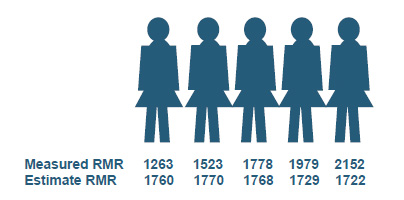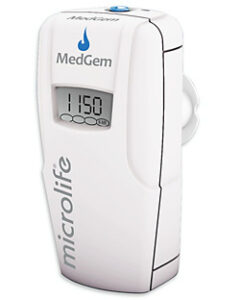Why is RMR Unique to Each Individual? Why Would It Change?
RMR is influenced by a number of factors, such as: body mass, body composition (the amount of fat and muscle), age, gender and hormones. Muscle burns more calories than fat; a person with a higher percentage of muscle will have a higher RMR.

In an example from a recent weight management study, subject 1 is a woman who weighs 158 pounds, a body fat percentage of 33%, and a measured RMR of 1571 calories per day. Subject 2 is a woman who also weighs 158 pounds, but has a body fat percentage of 48% and a measured RMR of 1252 calories per day.
At the same weight, similar height, and same age, these women have very different RMR values due to differences in body composition.
RMR declines naturally in adults at a rate of about 2% per decade, however, this decrease is primarily a result of muscle loss.
Men normally have a higher metabolism than women, partly because they tend to have a higher percentage of muscle compared to women. Certain hormones can also increase or decrease metabolism.
Additionally, the metabolic response to stress and injury influences RMR and necessitates measurement of VO2 rather than using formula-based estimates. Estimation equations do not take into account individual variability, pre-existing medical conditions, or the numerous other factors present that can affect RMR.
Weight Loss
When individuals lose weight, their metabolism may decrease. This should not be alarming because the decrease in metabolism is a result of tissue loss (fat and muscle).
Weight loss ideally results in proportionately more fat loss and some muscle loss. Strength training during weight loss can lessen the muscle loss, but most people will experience some muscle loss. During weight loss, the body may also lower metabolism in response to a lower calorie intake.
Most people experience this change in metabolism without realizing it. Weight loss may be easy for the first few pounds and then weight loss becomes more difficult and may even plateau. At a lower metabolism, an individual must adjust dietary intake or increase activity through exercise to lose additional weight.
The good news is that after weight loss, metabolism may increase slightly once the individual’s weight is stable. During weight loss, it is helpful to monitor changes in metabolism and make necessary adjustments to food intake for successful weight management.
 The Microlife BodyGem and MedGem indirect calorimetry devices measure your clients Resting Metabolic Rate, to optimize their weight loss results.
The Microlife BodyGem and MedGem indirect calorimetry devices measure your clients Resting Metabolic Rate, to optimize their weight loss results.
Instead of estimating RMR with the Harris-Benedict or Katch-McArdle formula, the BodyGem and MedGem scientifically measure a clients Metabolic Fingerprint, that is unique to them.
Estimation formulas cannot factor in thyroid issues, the effects of medications, etc.
For the best care, the American Dietetics Association recommends using indirect calorimetry to measure RMR for the most accurate assessment of nutritional needs.
The BodyGem and MedGem are the same type indirect calorimeter. They have the same functionality, accuracy and reliability.
The difference is that the MedGem is a FDA 510K-cleared, class II, medical device, which allows licensed clinicians to make insurance claims on their measurements.
CONTACT US:
Call 720-431-1461 to get your questions answered.
Or complete the CONTACT FORM and we’ll email you or call you.
If you’re ready to order a BodyGem or MedGem System Kit, complete the ORDER FORM and then call us with payment information.
We accept purchase orders from companies that have a net-30 credit account set up with us.